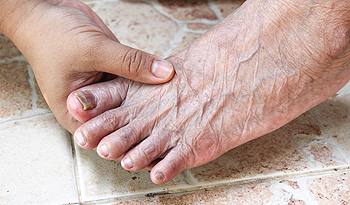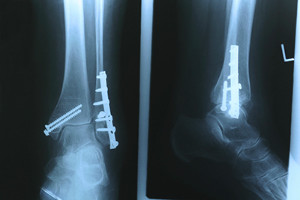
Wilmington (937) 382-2347
Fax
(513) 932-1606

Wilmington (937) 382-2347
Fax
(513) 932-1606
 Proper foot care is important to maintain, and this is especially true for older adults. When the toenails are trimmed correctly, the painful condition that is known as ingrown toenails may be prevented. Additionally, the skin can remain soft when the feet are washed and dried thoroughly, followed by applying a good moisturizer. It is beneficial to wear socks and shoes that fit correctly and to avoid walking barefoot. Many elderly people have difficulty in bending down to inspect their feet, thus it may help to put a mirror under the feet so that existing cuts and wounds can be seen. If you would like more information about implementing methods to take care of elderly feet, it is suggested that you consult with a podiatrist.
Proper foot care is important to maintain, and this is especially true for older adults. When the toenails are trimmed correctly, the painful condition that is known as ingrown toenails may be prevented. Additionally, the skin can remain soft when the feet are washed and dried thoroughly, followed by applying a good moisturizer. It is beneficial to wear socks and shoes that fit correctly and to avoid walking barefoot. Many elderly people have difficulty in bending down to inspect their feet, thus it may help to put a mirror under the feet so that existing cuts and wounds can be seen. If you would like more information about implementing methods to take care of elderly feet, it is suggested that you consult with a podiatrist.
Proper foot care is something many older adults forget to consider. If you have any concerns about your feet and ankles, contact Dr. Gerald Perelman from Ohio. Our doctor can provide the care you need to keep you pain-free and on your feet.
The Elderly and Their Feet
As we age we start to notice many changes in our body, but the elder population may not notice them right away. Medical conditions may prevent the elderly to take notice of their foot health right away. Poor vision is a lead contributor to not taking action for the elderly.
Common Conditions
Susceptible Infections
Diabetes and poor circulation can cause general loss of sensitivity over the years, turning a simple cut into a serious issue.
If you have any questions please feel free to contact our office located in Wilmington, OH . We offer the newest diagnostic and treatment technologies for all your foot and ankle needs.
As you get out of bed in the morning and place your feet on the floor, you feel a stabbing pain in your heel. What’s going on? It could be plantar fasciitis, an inflammation of the tissue running along the bottom of your foot. Luckily, there are ways to manage heel pain at home. Rest the foot by avoiding sports and other heavy impact activities such as running or jogging. Put an icepack under the heel for 15 minutes to reduce inflammation and swelling. Stretching your calf and foot muscles and giving yourself a soft-tissue foot massage may also help alleviate pain. While home remedies can be effective, if you find that home management techniques are not working for you, or if your pain is severe, it is recommended that you visit a podiatrist.
Many people suffer from bouts of heel pain. For more information, contact Dr. Gerald Perelman of Ohio. Our doctor can provide the care you need to keep you pain-free and on your feet.
Causes of Heel Pain
Heel pain is often associated with plantar fasciitis. The plantar fascia is a band of tissues that extends along the bottom of the foot. A rip or tear in this ligament can cause inflammation of the tissue.
Achilles tendonitis is another cause of heel pain. Inflammation of the Achilles tendon will cause pain from fractures and muscle tearing. Lack of flexibility is also another symptom.
Heel spurs are another cause of pain. When the tissues of the plantar fascia undergo a great deal of stress, it can lead to ligament separation from the heel bone, causing heel spurs.
Why Might Heel Pain Occur?
Treatments
Heel pain should be treated as soon as possible for immediate results. Keeping your feet in a stress-free environment will help. If you suffer from Achilles tendonitis or plantar fasciitis, applying ice will reduce the swelling. Stretching before an exercise like running will help the muscles. Using all these tips will help make heel pain a condition of the past.
If you have any questions please contact our office located in Wilmington, OH . We offer the newest diagnostic and treatment technologies for all your foot and ankle needs.
 A stress fracture is a common sports injury, often brought upon by overuse and repetitive activities. Stress fractures can occur when small cracks form in the bone. Quite often athletes may develop a stress fracture due to errors in their training technique. For example, it can be very damaging to suddenly increase the intensity of a work-out regime or to increase the amount of walking one does. Increasing the difficulty of training over the course of a few months can be much safer as opposed to a few weeks. Other factors such as improper equipment can also lead to the development of a stress fracture. Worn-out footwear, or shoes that are too stiff can also be damaging to how one performs their training. For further information on how to prevent getting a stress fracture, please consult with a podiatrist.
A stress fracture is a common sports injury, often brought upon by overuse and repetitive activities. Stress fractures can occur when small cracks form in the bone. Quite often athletes may develop a stress fracture due to errors in their training technique. For example, it can be very damaging to suddenly increase the intensity of a work-out regime or to increase the amount of walking one does. Increasing the difficulty of training over the course of a few months can be much safer as opposed to a few weeks. Other factors such as improper equipment can also lead to the development of a stress fracture. Worn-out footwear, or shoes that are too stiff can also be damaging to how one performs their training. For further information on how to prevent getting a stress fracture, please consult with a podiatrist.
Activities where too much pressure is put on the feet can cause stress fractures. To learn more, contact Dr. Gerald Perelman from Ohio. Our doctor can provide the care you need to keep your pain free and on your feet.
Dealing with Stress Fractures of the Foot and Ankle
Stress fractures occur in the foot and ankle when muscles in these areas weaken from too much or too little use. The feet and ankles then lose support when walking or running from the impact of the ground. Since there is no protection, the bones receive the full impact of each step. Stress on the feet can cause cracks to form in the bones, thus creating stress fractures.
What Are Stress Fractures?
Stress fractures occur frequently in individuals whose daily activities cause great impact on the feet and ankles. Stress factors are most common among:
Symptoms
Pain from the fractures occur in the area of the fractures and can be constant or intermittent. It will often cause sharp or dull pain with swelling and tenderness. Engaging in any kind of activity which involves high impact will aggravate pain.
If you have any questions please feel free to contact our office located in Wilmington, OH . We offer the newest diagnostic and treatment technologies for all your foot and ankle needs.
 One of the most important parts of keeping your feet healthy and pain-free involves preventative steps. To start, cleaning your feet and keeping them dry is key to avoid fungal infections that may grow in moisture. Fungal infections are common in public places such as pools, locker rooms, and showers. It is crucial to protect your feet with shower shoes when visiting these areas. Examining your feet is paramount in tackling issues early on. Peeling between the toes could signal athlete’s foot, and discolored nails may be an indication of a nail fungus. Choosing the correct footwear can also be beneficial for the feet. Purchase shoes at the end of the day when the feet are at their largest and avoid shoes that cramp the toes as this could lead to ingrown toenails, bunions, and calluses. If you are experiencing any type of foot pain or would like additional information on keeping the feet healthy, please speak with a podiatrist for professional care and treatment.
One of the most important parts of keeping your feet healthy and pain-free involves preventative steps. To start, cleaning your feet and keeping them dry is key to avoid fungal infections that may grow in moisture. Fungal infections are common in public places such as pools, locker rooms, and showers. It is crucial to protect your feet with shower shoes when visiting these areas. Examining your feet is paramount in tackling issues early on. Peeling between the toes could signal athlete’s foot, and discolored nails may be an indication of a nail fungus. Choosing the correct footwear can also be beneficial for the feet. Purchase shoes at the end of the day when the feet are at their largest and avoid shoes that cramp the toes as this could lead to ingrown toenails, bunions, and calluses. If you are experiencing any type of foot pain or would like additional information on keeping the feet healthy, please speak with a podiatrist for professional care and treatment.
Everyday foot care is very important to prevent infection and other foot ailments. If you need your feet checked, contact Dr. Gerald Perelman from Ohio. Our doctor can provide the care you need to keep you pain-free and on your feet.
Everyday Foot Care
Often, people take care of their bodies, face and hair more so than they do for their feet. But the feet are a very important aspect of our bodies, and one that we should pay more attention to. Without our feet, we would not be able to perform most daily tasks.
It is best to check your feet regularly to make sure there are no new bruises or cuts that you may not have noticed before. For dry feet, moisturizer can easily be a remedy and can be applied as often as necessary to the affected areas. Wearing shoes that fit well can also help you maintain good foot health, as well as making it easier to walk and do daily activities without the stress or pain of ill-fitting shoes, high heels, or even flip flops. Wearing clean socks with closed shoes is important to ensure that sweat and bacteria do not accumulate within the shoe. Clean socks help to prevent Athlete’s foot, fungi problems, bad odors, and can absorb sweat.
If you have any questions please feel free to contact our office located in Wilmington, OH . We offer the newest diagnostic and treatment technologies for all your foot and ankle needs.